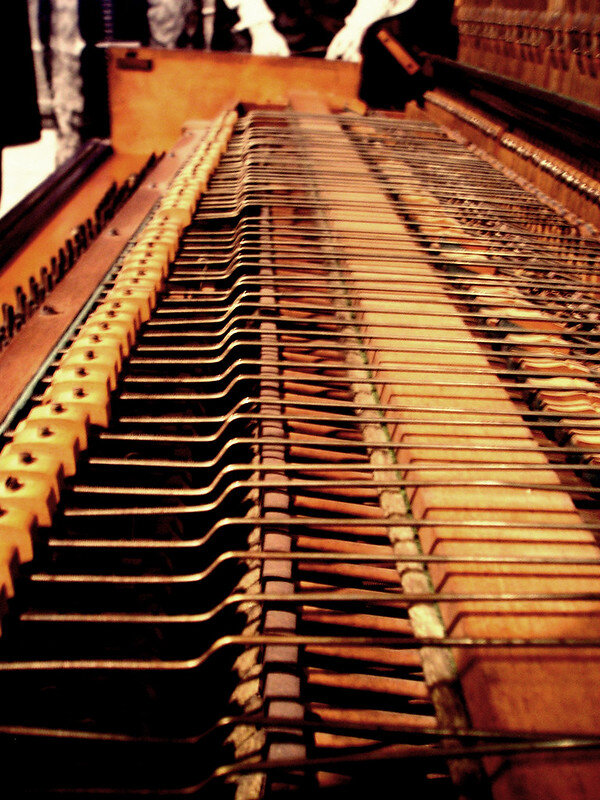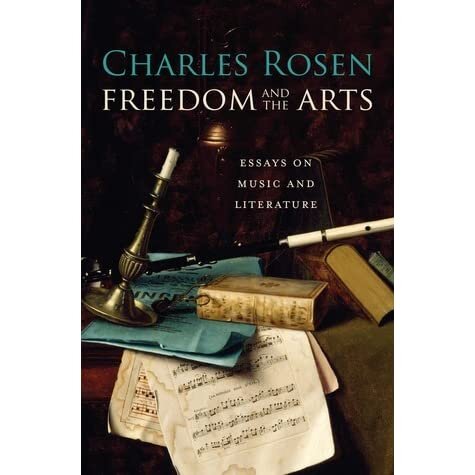The following review originally appeared in Issue 29 of The Quarterly Conversation.
Twentieth-century music has changed our understanding of Mozart and Beethoven.
What we now hear was, of course, always there.
— Charles Rosen
Freedom and the Arts: Essays on Music and Literature
by Charles Rosen
(Harvard University Press, May 2012)
Reviewed by Taylor Davis-Van Atta
How we interpret art—as individuals and collectively—is influenced by a complex of inherited and learned sensibilities peculiar to our time, and also by prior knowledge one brings to the experience: a book is read against the tapestry of all previously read books; within a piece of music wisps of prior recordings or performances, or even entirely other pieces of music, are heard; meanwhile, innate political, cultural, and aesthetic understandings are altering our perceptions and tastes. All of this input informs and heightens our experience of art, but it can also hinder the pure pleasure of an experience. Even a desire to understand or find meaning in art can itself be a limiting factor—a paradoxical idea when one considers that the main function of art may ultimately be to liberate us from the entrapments of meaning and/or from an antiquated understanding of the world around us. Having inherited modern sensibilities implicit in our time and culture, and limited by an incomplete knowledge of the conditions of past eras out of which some of our most enduring art emerged, we might raise a central question: to what degree are we, as individuals and as a public, able to exercise free will over our own interpretations and appreciation of art?
The critic, historian, music theorist, and virtuosic pianist Charles Rosen has spent the past half century examining this question, and his latest book, Freedom and the Arts: Essays on Music and Literature, a collection of 28 essays written mainly over the past 15 years, is his most expansive analysis to date of the challenges and pleasures of art. It contains his most direct attempts to address the question of free will in artistic interpretation. Endowed with enormous knowledge (what Pierre Boulez calls his “vast culture”), Rosen is a most gifted critic, one who not only explicates and illuminates scores and texts with easy precision but whose reviews and essays stand apart from their subject as pieces of literature in their own right. Rarely of one mind on any subject, except perhaps his preferences for certain recordings and particular fingerings, Rosen in this collection unapologetically contradicts himself and homes in on paradoxes he is unable to reconcile, engaged in a decades-long discussion with the finest artists of the past four centuries—and with his own mind. Above all, he elaborates on several lifelong arguments, making this volume a valuable companion to his major books, as well as a terrific introduction those who have not yet read his work.
As a pianist, Rosen’s performances are studies in technique; his light interpretative approach brings out the emotional heart of the music (rather than putting it in, as a less deft performer might). Likewise, the genius of his criticism lies in his ability to expose through examination of an artist’s technique the nervous system of the literature or music in question, allowing the emotional and intellectual vitality of the piece to come strikingly into light. His reading of Elliot Carter’s cello sonata (in “Happy Birthday, Elliot Carter!”), for instance, is the most perceptive I have read and chased me to my CD collection to experience the piece anew, wanting to test Rosen’s insight:
The cello sonata opens with the piano in strict time, ticking away in moderate tempo with a quiet percussive staccato. The cello, however, exists in a different space-time, with a long, lyrical, and eloquent line, irregular and seemingly improvised, very few of its notes coinciding with the beats of the piano. The opening may be the first example of Carter’s use of the long, expressive, singing arabesque line that was virtually absent in modernist style. . . . No previous work for cello and piano had ever differentiated the two instruments so distinctly, and exploited the sonority of each.
In his essays Rosen moves with ease between intimate examinations of texts—be they scores or poems—and the broader context in which we experience them. Central to all of Rosen’s writing is the question of how we might best appreciate the work in question, and because this is his point of enquiry, one typically needs only a passing familiarity with his subject to be engaged by even his most rigorous examinations. On Mallarmé, Rosen teaches us new ways of reading “the seemingly unreadable poet”:
The art of reading Mallarmé requires us to realize that the enigmatic surface of his poetry does not cover or hide a secret; and we cannot discard the surface once the treasure has been unearthed. The solution to the enigma is on the surface, which itself becomes the treasure as our experience of it grows. (“Mallarmé and the Transfiguration of Poetry”)
Rosen, who has championed (in writing) and debuted (in performance) 20th-century modernist work by Martinů, Bartók, Stravinsky, Boulez, Carter, and others, here brings uncanny clarity to even the most opaque literary achievements while furthering his lifelong impassioned defense of challenging literature. In a section of essays (“Classical Modernism: Past and Present”) on Mallarmé, Montaigne, Adorno, La Fontaine, Hofmannsthal, and W.H. Auden, it’s clear that, for Rosen, no other artistic movement in history has been met with so much hostility as the modernist. This section elaborates on one of the truths he revisits throughout the collection, namely that while we expect originality from our artists, we resent them when we get it (“Freedom and Art”). Modernism, to Rosen, involves an absolute fidelity to disagreeable human truths while transforming the repellent and awkward nature of facing these truths into something aesthetically beautiful, and, despite public reception, there is no higher human aspiration than the creation of an aesthetic achievement free of the entrapment of “meaning.”
Rosen’s essays on literature are remarkable for the tremendous breadth of knowledge on all artistic disciplines that he brings to his interpretations of literary works, a trait desperately lacking in literary journalism today. Rosen throws up no artificial boundaries: to his mind all arts speak to each other, each fluent in a singular artistic language. Mallarmé believed in a “musical universality”—a pure pleasure—that extends beyond the confines of any given artistic form, and this is an ideal Rosen seems to share.
Music, like much of literary modernism, carries no message, no “material communication” (Mallarmé’s term), and, in order to comprehend the emotional content of Mallarmé’s poetry or, say, Hofmannsthal’s libretti, Rosen argues we must “begin with a dispassionate understanding of the art and an appreciation of the technique.” This is not so different than the journey we have undertaken as a public to appreciate the music of Stravinsky, Carter, or even Mozart: it takes time for us to learn to hear and read as these artists would wish us to. Their technique is new, thus we must develop new techniques for appreciating them. Rosen expands the defense of modernism he has previously offered (most notably in Arnold Schoenberg (1996) and Critical Entertainments (2001)) by crediting the movement with nothing less than saving Western music, claiming that the modernist movement was a necessary and subversive act that first taught the public to hear Beethoven and Mozart in a manner that benefitted their music. We may indeed resent our most original artists, but it is their work that ultimately forms our canon. And the essential paradox of a canon, Rosen writes, “is that a tradition is often most successfully sustained by those who appear to be trying to attack or to destroy it. It was Wagner, Debussy, and Stravinsky who gave new life to the Western musical tradition while seeming to undermine its very foundations.”
In Piano Notes (2002), Rosen comments that it would be very difficult, if not impossible, for us to ever know what Beethoven’s playing or Bach’s ensembles sounded like in their time, so the attempt to attain “authenticity” in our interpretations of such masterworks is a fruitless and even counterproductive task: the inherent conflict of listening to an old-fashioned performance with contemporary ears risks limiting the pleasure we can take from the music. If musical interpretation is to remain a living art, he explains, we must abandon the pursuit of authenticity and acknowledge that the lifespan of a piece of music—or a book or painting—ultimately depends on our willingness to adapt our interpretations to best please our sensibilities. Throughout this collection, Rosen challenges this—his own—argument, writing in the collection’s final essay (“Old Wisdom and Newfangled Theory”):
I think we must conclude that the ideal form of works of art is always at least partially distorted by the conditions of their initial presentation and production and by their transference to new eras, new venues, or new media. We are not always aware of the damage done to productions of culture by the social conditions in which they were made and later by the new conditions that arise in the ages that inherit them.
Rosen seems to conclude that we should not fear losing artistic traditions; in fact, the only true loss may come if we insist on recreating older music with utter fidelity to the conditions in which it was conceived or, conversely, if we ignore the nostalgic charms that past exigencies can bring to our contemporary interpretations.
Freedom and the Arts also contains a 120-page section entitled “Mostly Mozart” which is easily one of the most approachable and enlightening collections of essays we have in English on our greatest Classical composer. The remarkable thing about this section, which comprises 7 essays Rosen wrote over the period of a decade, is that, for its breadth of subject matter and opinion, it could have been written by as many different scholars. That these essays all came out of one mind is downright astonishing and, plainly stated, they are some of the finest musical literature on Mozart written in our era, a wonderful supplement to Rosen’s (arguably) most important works, The Classical Style (1972) and Sonata Forms (1988).
Rosen opens (and ends) Freedom and the Arts with a new essay directly addressing the pleasures and challenges of interpreting art in modern times. On the difficulties of enjoying Montaigne’s writing today, he writes:
Only a rereading of his essays for the enjoyment of his style and his delight in contradicting himself will tell us that his conclusions are generally provisional and that the interest for the reader lies in the voyage . . . or rather, that the voyage (the demonstration of the way the mind works) was the real original goal all the time. (“Freedom and Art”)
The essays that follow this introduction are best thought of as think-pieces, snapshots of a peerless mind at constant odds with itself, not content with its own conclusions, nor with the voyage it took in reaching those conclusions. Rosen is challenging not the prevailing thinking of our time but his own trailblazing thoughts. At times this means that a line of argument is left incomplete, abandoned for the sake of following a fresher, if no more convincing, line of thought. But along the way, with casual offhandedness, Rosen eloquently expresses the scope of human achievement in the arts. The collection is thoroughly accessible, an act of generosity that makes readily available to listeners and readers what gives pure pleasure to the artist.
Taylor Davis-Van Atta is the founding editor of Music & Literature.
Banner: “Piano” by christoph habel. Reproduced under a CC BY-NC 2.0 license.


